Landscapers cutting back grasses too early!!!!
Has anyone noticed landscape contractors (that take care of large shopping centers, and buisness landscapes) cutting back the ornamental grass plantings in the fall? Normally in colder areas it is always suggested to NOT cut back ornamental grasses until March to insure the crowns are well protected from severe sub zero temperatures.
I suppose that since many grasses tend to loose foliage throughout the winter that the "neat and tidy" syndrome has taken over when a few fastidious property owners noticed a few blades laying in their parking lot. I noticed this when a normally beautiful grass planting nearby that usually has lasting winter interest was cut back before Thanksgiving. Before long more than half of the plantings around town were being crew cut. Fall /Winter interest is one of the main attractions for Ornamental grasses in my opinion. I certainly don't grow most of them just for the foliage!
The area I have noticed this in is Cincinnati Metro (specifically Northern KY).
Comments (17)
dereks
19 years agoIt's the same thing here. At the mall there is a beautiful row of miscanthus grasses. They are cut down right after they bloom in october. Can't they at least wait until november?
gardengal48 (PNW Z8/9)
19 years agoCommercial landscapes are typically designed with durability and ease of maintenance as primary concerns. Tidiness and potential liabilities are also considered. While many OG's will look lovely with their winter presence, they can just as often suffer from winter winds, excessive snowloads and other winter weather that leaves them splayed out and bedraggled. While this is generally not a huge concern for a home gardener, it is NOT the look most shopping center managers and owners of other commercial properties desire. And there is also the issue of the timing of the routine maintenance - work is done when it is convenient and scheduled, not necessarily timed to coincide with various seasonal attractions of the subject plants.
If the grasses are hardy for your zone and established, there is minimal winter protection provided by leaving the foliage intact. Aside from aesthetic conerns which will differ depending on where and who is growing the grasses, there is no valid reason not to cut back in late fall.
Related Professionals
Ballenger Creek Landscape Architects & Landscape Designers · Grand Haven Landscape Architects & Landscape Designers · Piqua Landscape Architects & Landscape Designers · Port Royal Landscape Architects & Landscape Designers · Bell Gardens Landscape Contractors · Paso Robles Landscape Contractors · Shoreview Landscape Contractors · Wilton Landscape Contractors · Bensenville Landscape Contractors · Franklin General Contractors · Halfway General Contractors · Hanford General Contractors · Highland City General Contractors · Leon Valley General Contractors · Walnut Park General Contractorsjake
19 years agoAs much as I agree with g-48 I am compelled to disagree as well. I feel the ornamental grasses need to be maintained in their entirety even through the autumn / winter seasons.
Yes the "maintenance" companies obviously are doing their job as stated, for convenience as in time and schedule and not for the health, beauty and welfare of the plants being maintained.
The buck stops here or maybe the money stolen from the unknowledgeable or donÂt want to get my hands dirty clientele, goes to those that aren't afraid to take it and run.
What business, and I am not trying to single out any type of business, has a clean parking lot? Like no trash flying around or plastic pop bottles run over and laying in the gutters. Baggies from the local Super store hung up on a shrub?
So what part of the clean maintenance does cutting the grasses back early have to do with ruining winter interest? Again I agree with g-48 but still as a plant owner one should take a vested interest in the plants, learn their value and the natural settings and characteristics of such.
Send the maintenance crew out there in the winter to clean up the fronds that wonder as most likely the crew members are collecting unemployment or flipping boogers down the street.
IÂm just being a thorn in statements made that are factual yet wrong in the necessity of doing business.
Jake
gardengal48 (PNW Z8/9)
19 years agoMy dear, I think you need to get out in the real world. I've yet to meet a property manager that gave a hoot about the cultural care of the plants on his property other than to keep them alive and tidy. I agree that not all landscape maintenance outfits are knowledgeable, but the ones that are in business for longer than a season or two are, particularly companies that focus on commercial landscapes. They work at the direction and timing of the individual hiring them. If the property manager has requested that all herbaceous material be cut back and cleaned up for the season, that is what they do.
And while it is typically suggested that ornamental grasses be cut back in late winter or early spring, it is done so primarily to take advantage of their winter effect, not because they CANNOT be cut back earlier. In fact, a number of authorities recommend cutting back newly planted (as in the previous summer) grasses in fall and mulched to increase their ability to survive that first winter in the ground. And if you are in area that receives snow in quantity in winter, that is usually sufficient insulation for most herbaceous plants that have been cut back. If the grass varieties are borderline hardy, you will get better results overwintering from cutting back in fall and mulching than you will with allowing foliage to remain intact through winter - it just doesn't offer that much protection.
I like the winter effect of ornamental grasses as much as the next person, but one has to understand that A) commonly accepted cultural practices are not set in stone, and B) owners of businesses hire work done when it is convenient and makes sense to them, not according to some intangible and often impractical sense of aesthetics.
Kris_Stone
Original Author19 years agoIn fact I am in the real world as far as the green industry in my area, and I happen to be one of the leaders of the green industry in this area. I'm very thankful that property managers are not the ones setting green industry standards. :-)
Hence, this is why we have loads of classes booked all growing season on proper care of ornamental grasses because the general public is confused by publications after they see a couple landscape industry professionals taking short cuts in the fall.
I grow dozens of species of ornamental grasses at our Arboretum and Parks system. Some grasses that have been cut back in the fall in this area clearly suffer and come back extremely weak after winters of -10F or colder.
Since the majority of the public only grow Miscanthus, and this genus is easily damaged by being cut back in the fall as a rule why encourage a widespread practice that is likely to cause problems locally? Cutting back all grasses in the spring will not cause damage... cutting back the plants in the fall may risk damage to several species in northern climates.
Where you live yes it probably doesnt matter, but for about 75% of the rest of the USA it does matter.
Your attitude is why we have "mulch volcanoes", pruning stubs that rot, and poorly installed plant material that dies in the landscape prematurely. The public follows these leads and it costs us all money and headache to deal with later. Oh, thats right...I guess that is called "job security."
In fact it is your responsibility to educate your clientel not just do exactly what they want. Good reputable companies will also walk away from a customer if they pride themselves on doing everything correctly.
If they dont listen and hire someone else to do what they want...then thats where people like me step in to fight the war. Eventually they will get public pressure to change.
I think a few buisnesses locally are getting that message already by a few people... ;-)
Eakr
19 years agoHaving grown grasses for 15 years, my own experience with Miscanthus ornamental grasses is that I can not really tell any difference between cutting them back late Fall (early December after a # of freezing nites) and early Spring. I usually leave them alone until Spring, basically out of laziness. However, I have cut them back in early December after strong wind/ early snow has knocked the grass down, ruining the aesthetic appearance. I can't believe that cutting/removing a dead stalks will have any affect on the root system. If it does, that shopping center landscaper would probably be happy, because less division of the plants would be involved in the coming growing seasons. In addition, shopping centers generally are partially protected from winter winds, giving a slightly higher Zone reading than unprotected areas. As a shopping center landscaper, I would be more concerned about the run-off water containing salt applied to a shopping center blacktop and sidewalks after a Winter snowfall, as well as that salt water aerosol created by vehicle tires, than from early cutback of the grass. Some agricultural University must have done some published research work which shows the effects of cutting ornamental grasses at various stages of it's annual growth cycle. Ed
nckvilledudes
19 years agoI am like Eakr. I have always cut my ornamental grasses back here in zone 7a NC in late December at the absolute latest. In my area, we typically have late fall hurricaine remnants come through that splay my stands of grass over. I attempt to prevent this by roping them up prior to a storm. Then late fall/early winter, we start having ice storms that weigh the branches down and snap them off. The winds also tend to break the clumps of grasses up and you end up with one big mess of grass stalks hanging down and broken off and blowing around the rest of the season until late winter/early spring. I cut back early to prevent all that messiness and to keep peace with the neighbors. Never has hurt my grasses in the almost 20 years of growing them.
gardengal48 (PNW Z8/9)
19 years agoKris, I think you are missing the point. With few exceptions there is no valid reason why most Miscanthus cultivars CANNOT be cut back in fall. A good many are hardy to zone 4, the vast majority to zone 5 and few more tender cultivars to zone 6. With the exception of the slightly more tender condensatus cultivars, they are root hardy to at least -20F, some to -30F. It is highly unlikely leaving the dead stalks through winter will significantly increase winter hardiness except in very marginally hardy cases. Cutting back in spring for most OG's is only an option, not a requirement.
I am also a bit confused about a couple of other statements you made. "the majority of the public only grows Miscanthus". That's a pretty broad statement and unlikely to be supported by fact. In a number of southwestern states, including Kentucky, Miscanthus sinensis and many of its cultivars are considered invasive and not recommended to be grown. And you are ignoring the popularity of scores of other grass species - Calamagrostis, Panicums, Pennisetums, Deschampsia, Stipas and all the native prairie grasses and sedges that are so popular, not to mention bamboos and all the grass-like plants commonly grouped as OG's, like liriope and mondo grass. Gardeners are a diverse bunch and live and garden in diverse conditions and making blanket statements such as this is innaccurate and misleading.
Miscanthus is not easily damaged by cold except in areas of borderline hardiness, like most other plants. While I currently live and garden in zone 8, I have also gardened in colder climes and cutting back most miscanthus in zone 5 (eastern WA) in fall or early winter never compromised the health of the plants I grew there. I would look to other reasons why your miscanthus are not doing well if cut back in fall or early winter as opposed to spring.
And finally I think you are confusing aesthetic concerns with cultural requirements. Cutting back dead top growth of any herbaceous plant can be done at any time. There is some slight benefit afforded by leaving dead plant material intact over the winter but only an increase of a few degrees of protection, far less than what would be accomplished by mulching or by the insulating factor of snow. Certainly not a concern when the plant in question is hardy to a zone or two or more lower than your current location. And in areas where miscanthus is invasive, it makes very good sense to cut the grasses back early so that the seed is not dispersed by winter winds.
As for my responsibilities as a professional in the green industry, I am well aware of them. And the dispersal of accurate information is paramount among them. And if I were you, I'd be a bit more concerned about your responsibilities as a green industry professional in encouraging the planting and spread of potentially invasive plants in your area.
Here is a link that might be useful: Kentucky - invasive species
Kris_Stone
Original Author19 years agoMy statement of "the majority of the public only grow Miscanthus" is true in many areas particularly locally where nurseries are just now starting to offer broader selections of other species like those you mentioned. Average Joe who isnt a gardener and only cares about having a nice looking landscape is still gravitating to Miscanthus. Drive down any subdivision locally and at least 75% of the grasses planted will be Miscanthus cultivars. Most people where I live are not gardeners, and many have landscape companies come out to take care of their landscape for them. This is a common trend in suburban landscapes at least locally unfortunately.
Yes, increasing numbers of other species are finally showing up.
Another benefit of leaving plant material through the winter is shelter and food for birds and animals. Removing the tops removes any benefit that may occur.
I previously worked for the KY Native Plant Program at the KY Dept of Fish and Wildlife resources, and have been a member of the KY Native Plant Society as well. Therefore I am very well aware of invasive species issues. Yes, in southeastern KY especially (and a few other areas) Miscanthus species are running rampant. Invasiveness however is dependant on lots of factors including local soil type, climate, location etc.
I do not encourage the spread of invasive species in my local area. So far Miscanthus has not become an issue in Northern Kentucky, Southwestern Ohio, and Southeastern Indiana...but I realise it could become a problem just like Ornamental Pears, Amur Honeysuckle...ect have.
Managing a collection in an Arboretum is a delicate balance between catering the horticultural industry needs, native plant needs, and showcasing new plant material with a wary eye. None of these interest must override the other otherwise you risk public outcry from someone in the various interest groups.
If there is a general cultural consensus on managing plant material it needs to adopted and practiced by everyone to help us educate the public on what is acceptable. Right now all we are doing is confusing the public by fighting over what is right and wrong.
Thuja
19 years agoAround here I notice more and more plantings where the grass is not cut back until spring. There is a place nearby where the grasses were all cut back in fall to about a foot. I didn't look close but it looked like Miscanthus. I'll try to report back on how it does this spring.
There is a turfgrass research center nearby too which grows many OG's. They cut the seed heads off in fall but leave the culms & leaves until spring.
MarthaLouis
19 years agoI think that cutting back the grasses in the fall is to each ones individual preference. I also believe that the Landscapers have a responsibility to inform the owner of the advantages and disadvantage of when to cut back. Some of the people don't worry about it because they can afford to replace it. If they choose to take the chance of loosing the plant then they miss out on the beauty of the mature plant. My preffernce is to wait until spring. I love the looks of the grass in the winter time, my birds love the seeds, They are graceful blowing in the wind.
sbeuerlein
19 years agoIs there any truth to that trimming back grasses or hollow stemmed perennials causes open "straws" that lead water into the crown and can cause it to rot in cool wet conditions? Like a lot of information to be found in gardening, this has a certain logic to it, but I haven't worked out whether it is actually true.
Scott
rivers1202
19 years agoDidn't rot any of my ornamental grasses, and we had lots of cold, wet conditions this winter. The ground is still extremely damp, in fact. I cut back low-growing groundcover ornamental grasses, and much larger grasses like Miscanthus, etc. No problems. I just transplanted most of them a few days ago to a bed that I made especially for my large OG's, which have all been cut back to about a foot tall. All of the root systems and crowns are healthy...no rot. And there is quite a bit of new green growth on all of them with the exception of the fountain grass. Although the root system of the fountain grass looks great (was no easy task getting it out of the ground for transplanting), I haven't seen new growth yet. Guess it's still too early for it.
Maybe I just lucked out. *shrug*jake
19 years agoT'ain't ever been to SC-USA so I really shouldn't say much other than " . I don't believe that zone 8a is a zone that would make a difference if you cut orn grasses in the fall or the spring."
Being in a colder, most times snowy w/ very chilly or cold wind chills and throw in some freezing rain you have our or my standard "winter" weather and this I believe might be more crucial versus aesthetic.
To me, the real necessity of cutting back the grasses has more to do with the new growth as well as the mess one would have if they did not cut back and collect the dead fronds.
Cutting the grasses to a height of 12" or more leaves a sizeable amount of "stubble" that will break off and end up flying around the yard and into other garden beds.
It has been stated in another post that orn grass waste makes a good compost but after 3 years of trying to get our orn grass fronds and stems to break down I shitte canned the whole process.
Orn grass refuge makes an excellent fire starter very similar to newspaper and thatÂs about the extent of value from my perspective.
Jake
littlebibs
19 years agoInteresting notes, to each their own I guess. I love
to watch the grasses change in the fall, blow in the breeze
listen to it late at night with the windows open on warmer
fall evenings. I can perfectly understand how those who
only seek for the seasonal"look" for their properties much
like those who buy hundreds of fall "mums" for "fall" and
discard them before the first really cold day feel about
these grasses but its a designer look and meant to move
on, many are just seeing these grasses over the past several years. Its nice that we who grow them for the whole
season feel like we need to leave them, it looks great when
those varieties that can take the snow, wind, ice stay
up all winter. I choose carefully and avoid grasses that
flop. I do love the varigated miscanthus even though it
flops, I sometimes cut it back in November but the others
I let them do their think, If those people want to cut back so what.. their loss, I still have mine!Thuja
18 years agoWell, I finally took notice of the grass planting I mentioned above that was cut down in the fall. It is gone, replaced with non-grasses. Not sure what conclusions, if any, can be drawn.



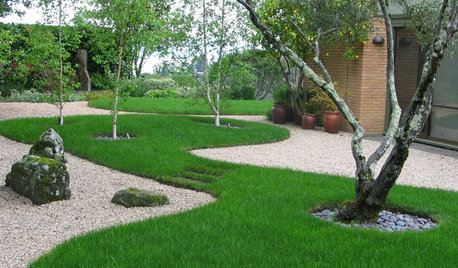
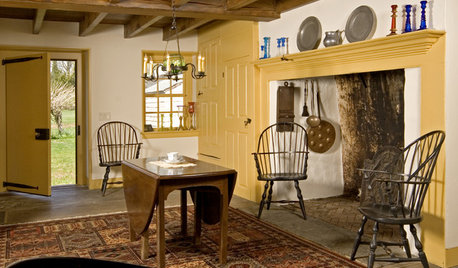

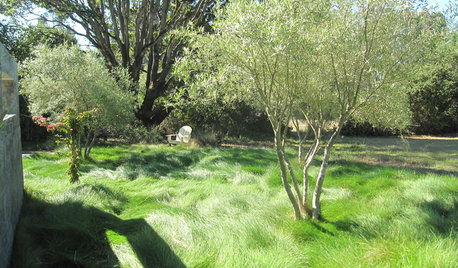
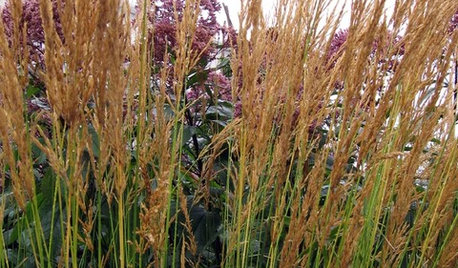

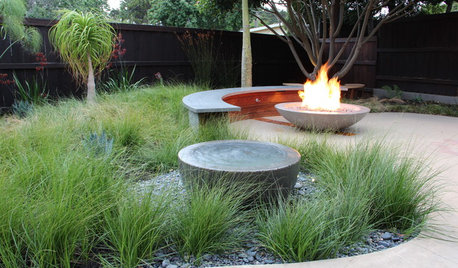







Kris_StoneOriginal Author